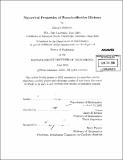| dc.contributor.advisor | James McKernan. | en_US |
| dc.contributor.author | Lehmann, Brian (Brian Todd) | en_US |
| dc.contributor.other | Massachusetts Institute of Technology. Dept. of Mathematics. | en_US |
| dc.date.accessioned | 2010-12-06T17:36:22Z | |
| dc.date.available | 2010-12-06T17:36:22Z | |
| dc.date.copyright | 2010 | en_US |
| dc.date.issued | 2010 | en_US |
| dc.identifier.uri | http://hdl.handle.net/1721.1/60194 | |
| dc.description | Thesis (Ph. D.)--Massachusetts Institute of Technology, Dept. of Mathematics, 2010. | en_US |
| dc.description | Cataloged from PDF version of thesis. | en_US |
| dc.description | Includes bibliographical references (p. 69-71). | en_US |
| dc.description.abstract | Suppose that X is a smooth variety and L is an effective divisor. One of the main goals of bi rational geometry is to understand the asymptotic behavior of the linear series... as m increases. The two most important features of the asymptotic behavior - the litaka dimension and the litaka fibration - are subtle and difficult to work with. In this thesis we will construct approximations to these objects that depend only on the numerical class of L. The main interest in such results arises from the Abundance Conjecture which predicts that the Iitaka fibration for Kx is determined by its numerical properties. In the second chapter we study a numerical approximation to the Iitaka dimension of L. For a nef divisor L, this quantity is a classical invariant known as the numerical dimension. There have been several proposed extensions of the numerical dimension to pseudo-effective divisors in [Nak04] and [BDPP04]. We show that these proposed definitions coincide and agree with many other natural notions. Just as in the nef case, the numerical dimension v(L) of a pseudo-effective divisor L should measure the maximum dimension of a subvariety ... such that the "positive restriction" of L is big along W. In the third chapter, we analyze how the properties of the Iitaka fibration OL for L are related to the numerical properties of L. Although the numerical dimension detects the existence of "virtual sections", it does not have a direct relationship with the Iitaka fibration. However, we do construct a rational map that only depends on the numerical class of L and approximates the Jitaka fibration. This rational map is the maximal possible fibration for which a general fiber F satisfies v(LIF) = 0. Thus, this chapter recovers and extends the work of [Eck05] from an algebraic viewpoint. Finally, we use the pseudo-effective reduction map to study the Abundance Conjecture. | en_US |
| dc.description.statementofresponsibility | by Brian Lehmann. | en_US |
| dc.format.extent | 71 p. | en_US |
| dc.language.iso | eng | en_US |
| dc.publisher | Massachusetts Institute of Technology | en_US |
| dc.rights | M.I.T. theses are protected by
copyright. They may be viewed from this source for any purpose, but
reproduction or distribution in any format is prohibited without written
permission. See provided URL for inquiries about permission. | en_US |
| dc.rights.uri | http://dspace.mit.edu/handle/1721.1/7582 | en_US |
| dc.subject | Mathematics. | en_US |
| dc.title | Numerical properties of pseudo-effective divisors | en_US |
| dc.type | Thesis | en_US |
| dc.description.degree | Ph.D. | en_US |
| dc.contributor.department | Massachusetts Institute of Technology. Department of Mathematics | |
| dc.identifier.oclc | 681936023 | en_US |
